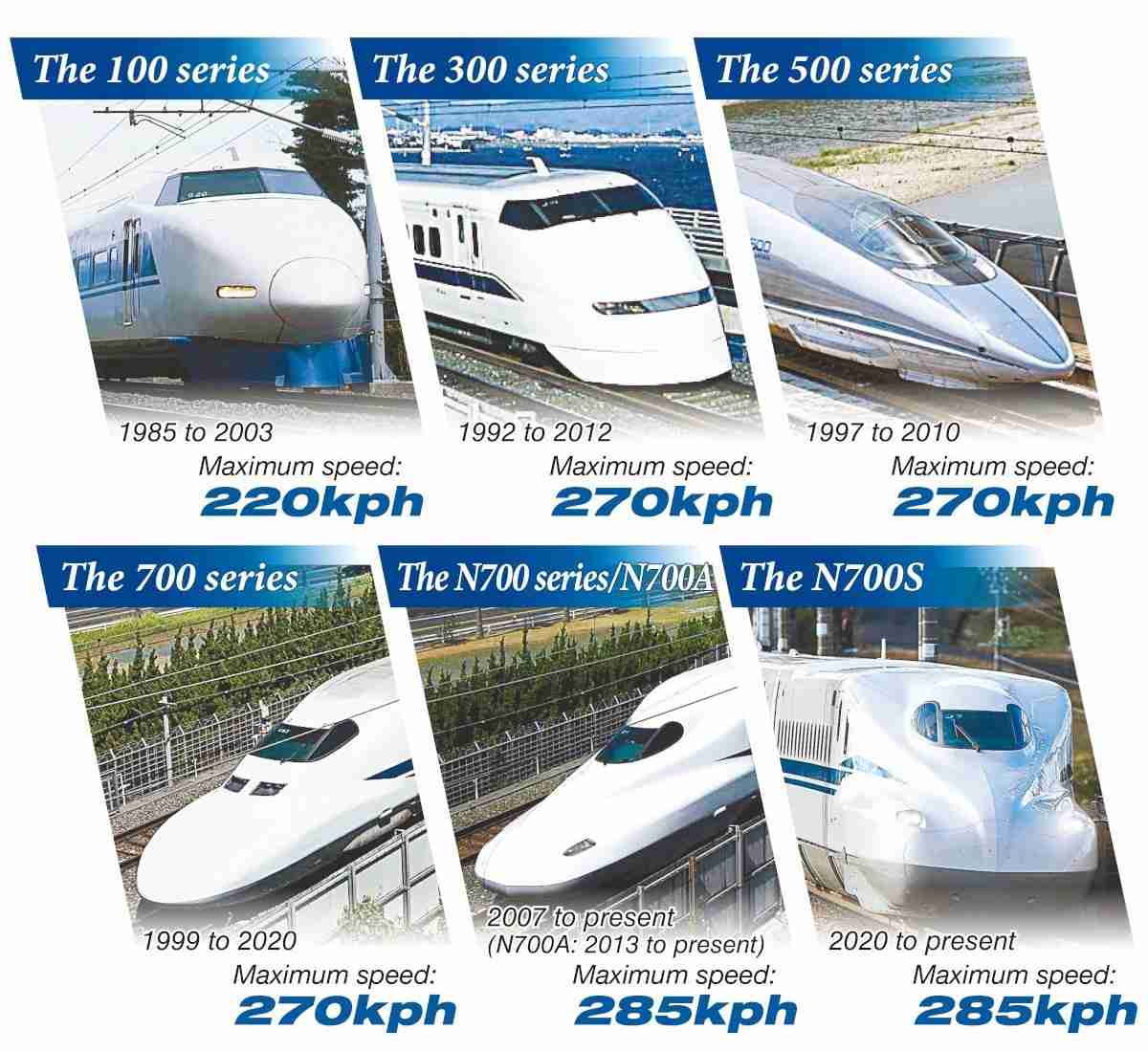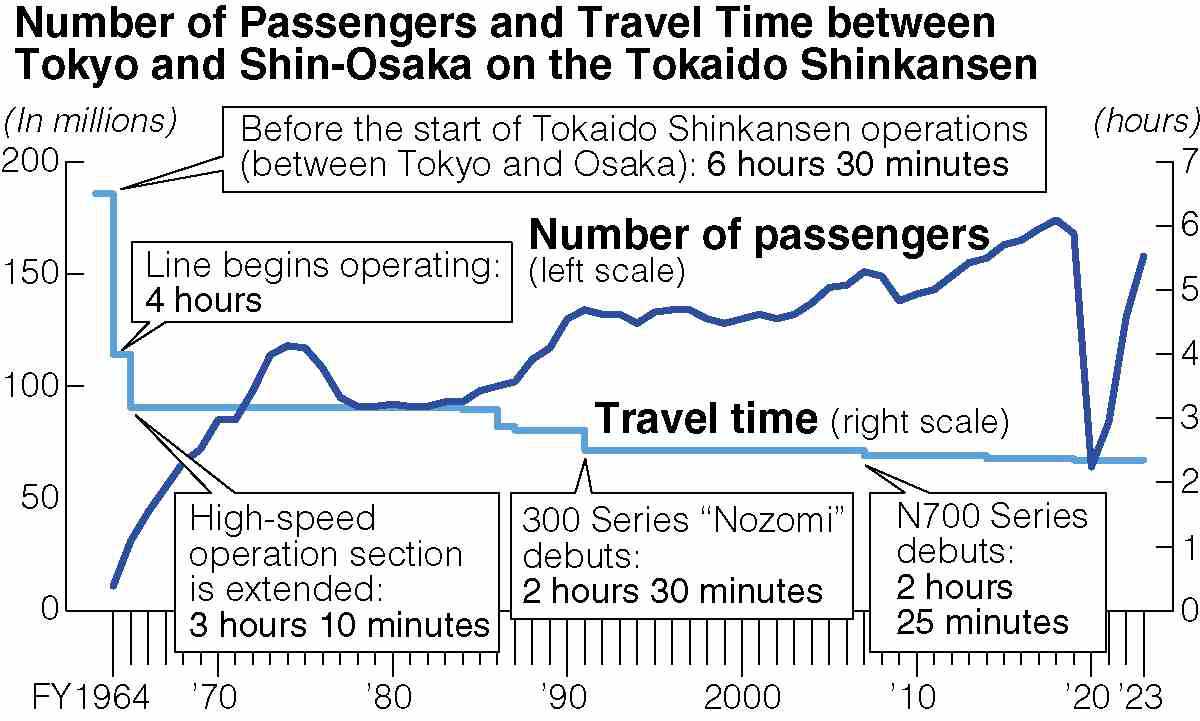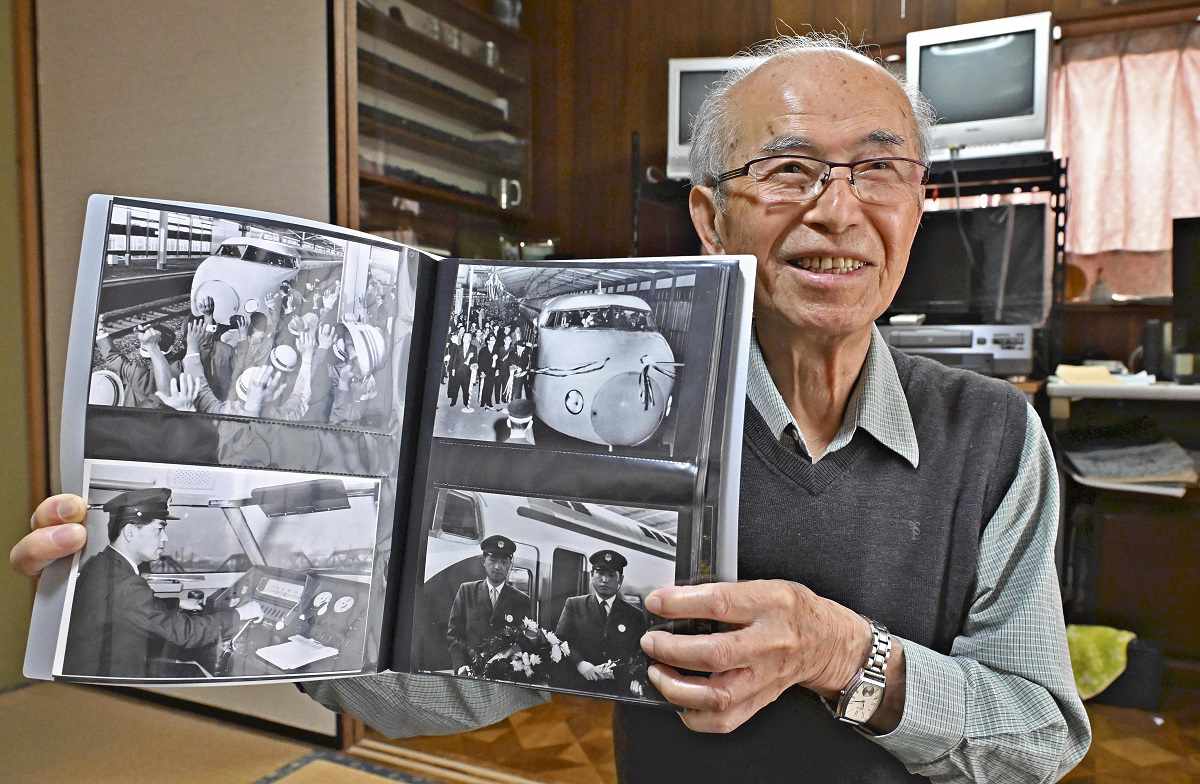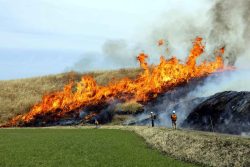

Maximum speeds and operation periods are for the Tokaido Shinkansen section. Maximum speeds on the Sanyo Shinkansen section are 300 kph for the 500 series, N700 series/N700A and N700S, and 285 kph for the 700 series.
10:48 JST, November 11, 2024
The Tokaido Shinkansen, which links the three major metropolitan areas of Tokyo, Nagoya and Osaka, has been running in tandem with Japan’s economic and social development ever since it began operating on Oct. 1, 1964.
The bullet train line has been used by a total of approximately 7 billion passengers to date, and not a single passenger has ever been killed in a derailment, collision or other train-related accident, showing just how safe the system is.
At home, the Tokaido Shinkansen recently celebrated its 60th birthday. It is even expanding its operations overseas. What sort of future waits down the line for the “dream super-express?”
Hopes for a ‘bullet train’
“Shinkansen,” meaning “new trunk line,” is a term coined by the now-defunct Japanese National Railways (JNR) to refer to a new major railroad line it planned to build. The term was first used back in 1939, during the second Sino-Japanese War.
At the time, the demand for rail transportation was growing along with Japan’s expansion into the Asian continent. The then Railways Ministry compiled a “bullet train plan” to connect Tokyo and Shimonoseki (in Yamaguchi Prefecture) in nine hours. The ministry made the official decision to build it in 1940.
The term “Shinkansen” remains in documents and other materials written back then. Although the plan was suspended due to the worsening war situation, the land and tunnels that had been prepared for its use were later utilized for the construction of the Tokaido Shinkansen.
The plan to construct the Shinkansen was promoted by Shinji Sogo, who served as the fourth president of JNR from 1955 to 1963 and was later called the “father of the Shinkansen.”
The challenges of securing funds and land were overcome, and JNR managed to get the Shinkansen into service shortly before the Oct. 10 opening ceremony of the 1964 Tokyo Olympics.
At that time, the maximum speed of the Shinkansen train was just over 200 kph, and it took exactly 4 hours to travel between Tokyo and Shin-Osaka stations.
Privatization: Back in the black
With the safety of the Shinkansen’s tracks and rolling stock confirmed, the high-speed section of the line was extended, and the time required to travel between Tokyo and Shin-Osaka was reduced to 3 hours and 10 minutes in 1965.
Consequently, it became popular to use the Shinkansen to make one-day business trips, thus indirectly supporting the country’s economic growth.
In anticipation of the 1970 Osaka Expo, the Tokaido Shinkansen “Hikari” train, which had previously consisted of 12 cars, was increased to 16 cars to boost its transportation capacity.
The Hikari trains reportedly carried approximately 10 million passengers to and from the Expo, winning it a reputation for being “a moving pavilion.”
In 1972, the Sanyo Shinkansen started its operation between Shin-Osaka and Okayama stations. With the slogan “Hikari goes west,” the Tokaido Shinkansen began services directly linking it to the Sanyo Shinkansen. In 1975 service expanded further southward as far as Hakata Station in Fukuoka.
In the 1980s, the worsening corporate management of JNR drew much public attention. In 1985, the government’s committee to supervise JNR’s reconstruction recommended that JNR be split up and privatized to prevent it from falling into the red again.
On April 1, 1987, JNR was split up to form regional Japan Railway (JR) companies, including JR Tokai (Central Japan Railway Co.), taking over the Tokaido Shinkansen business.
A huge global impact
The Tokaido Shinkansen has achieved technological progress while operating safely, and it has also managed to increase its speed and passenger load while decreasing its weight, making mass transportation a reality.
The first-generation Shinkansen train, the 0 series, popular for its “pug nose,” became the first commercially-operated train in the world to run at 210 kph.
The 100 series train, equipped with a two-story green-sha (upgraded car), was introduced in 1985. In 1992, the 300 series train, whose carriages were lighter than earlier series cars because they were made with aluminum alloy, made its debut.
The 700 series Shinkansen, called the “duckbill” train because of the shape of its nose, was introduced in 1999 with a structure designed to reduce swaying, followed by the N700 series, which in 2015 achieved a maximum speed of 285 kph. The N700 series later evolved into the N700A, leading to the N700S, the latest model.
The success of the Tokaido Shinkansen had a huge impact on railroad planning around the world. Inspired by the Shinkansen, France began operation of its high-speed TGV in 1981, followed by Germany’s ICE in 1991.
Shinkansen technology has also spread overseas.
Taiwan High Speed Rail (THSR) began operating in 2007, marking the first time Japanese Shinkansen technology had been exported overseas. The THSR uses Japanese rolling stock technology and signaling systems.
Drop in passengers

The COVID-19 crisis that raged in 2020 also dealt a heavy blow to the Tokaido Shinkansen. The number of passengers during the Golden Week holiday period that year was down to 6% of what it had been in 2019, the year before the pandemic.
Natural disasters have also posed a threat to the Shinkansen line in recent years. In August and September this year, due to typhoons and other factors, planned service cancellations were implemented.
Compared to other Shinkansen lines, the Tokaido Shinkansen has many sections where the track runs on raised ground, making it more vulnerable to rain and wind. Although measures have been implemented such as reinforcing slope faces and strengthening drainage systems, some vulnerabilities still remain.
JR Tokai President Shunsuke Niwa said: “Through the COVID-19 pandemic, people’s lifestyles have changed. We will strive to improve our new products and services.”
He then added: “Transportation safety is our top priority. We want to make [the Shinkansen] a more reliable means of transportation by increasing its level of safety.”
The Tokaido Shinkansen has won a worldwide reputation for its excellent performance. Achieving a higher level of safety will require constant effort.
‘I hope it will remain a main artery of Japan,’ first driver reminisces

Kazutaro Oishi, who drove the train that made the very first public journey on the Tokaido Shinkansen Line, reminisces as he holds an album of photos from the day of that trip.
“I was filled with a sense of achievement when I safely delivered my passengers to Tokyo,” recalled Kazutaro Oishi.
Oishi, 91, drove the first Shinkansen, the “Hikari No. 2,” from Shin-Osaka Station to Tokyo Station on the day it began operation.
Oishi, who had previously worked at a factory in Tokyo, began working for JNR in 1953, serving as a driver of the “Kodama” and “Tsubame” special express trains.
Back then, many people saw the Shinkansen as unnecessary. It was mocked as one of “the four most useless things in the world,” following the Egyptian pyramids, the Great Wall of China and the Battleship Yamato.
But Oishi, who liked anything new, was rather excited when he learned that drivers were being recruited, and he tried his luck by applying for the job.
After being assigned to the office tasked to prepare for the start of Shinkansen service, he began spending every day performing test runs. Although there were some problems, such as defects in the tracks, he was able to run the train up to a speed of 210 kph many times.
It was about a month before the first day of operations that he was named as the driver of the first train. He was moved, thinking: “I am the one who did the most test runs. My superiors must have nominated me because they thought, ‘If he can’t do it, who could?’”
On the morning of Oct. 1, 1964, the platform at Shin-Osaka Station was jammed with more than the expected number of passengers and staff.
The train departed the station at 6:00 a.m. At Kyoto Station, laborers who had been hard at work doing maintenance until just before its arrival saw the first train off, their hands and faces still covered with grime.
There had never before been a commercially operated train that ran at over 200 kph, and expectations were high all over Japan.
However, for reasons of safety and other considerations, the Shinkansen was intended to run at no more than 160 kph that day. Running the train at 210 kph was permitted only if needed to make up time lost during delays.
Oishi decided to drive slowly through the tunnel in Kyoto. Then, on a straight stretch of track near Otsu in Shiga Prefecture, he sped up. In just a moment, the speedometer by the driver’s seat indicated that the train was running at 210 kph.
Oishi recalled how he felt back then: “I knew that many of my peers had been working hard to prepare for the start of services, including those who built the tracks and those who installed the overhead wires. As the driver, whose work would be the culmination of their efforts, I wanted to give them what they were expecting by driving the train at over 200 kph.”
Passing near Shimbashi, Tokyo, Oishi slowed down to remain in accordance with the schedule. As the train rolled by, people stuck their heads out the windows of office buildings and waved their handkerchiefs in welcome. The first Shinkansen train pulled smoothly into Tokyo Station at exactly 10:00 a.m., as scheduled.
Oishi, who continued driving Shinkansen trains for about 20 years and also provided guidance to junior drivers, smiled and said, “I couldn’t have imagined back then that [the Shinkansen] would still be loved by so many people even 60 years after its debut.”
Turning his thoughts to the “dream super-express,” which has advanced along with the country’s postwar development, he said: “After all, the Shinkansen is indispensable, isn’t it? I hope the Shinkansen will continue to support people’s daily lives as a main artery of Japan.”
"JN Specialities" POPULAR ARTICLE
-

The Japan News / Weekly Edition (12/12-12/18)
-

English-language Kabuki, Kyogen Entertain Audiences in Tokyo; Portland State University Professor Emeritus, Graduates Perform
-

Noodle Dining Shunsai / Rich Oyster Ramen to Savor at Odasaga; Experienced 68-year-old Owner Creates Numerous Ramen Varieties
-

The Japan News / Weekly Edition (12/5-12/11)
-

People Keep Loved Ones’ Ashes Close in Special Jewelry, Small Urns as Unique Way to Memorialize Them
JN ACCESS RANKING
-

Keidanren Chairman Yoshinobu Tsutsui Visits Kashiwazaki-Kariwa Nuclear Power Plant; Inspects New Emergency Safety System
-

Imports of Rare Earths from China Facing Delays, May Be Caused by Deterioration of Japan-China Relations
-

University of Tokyo Professor Discusses Japanese Economic Security in Interview Ahead of Forum
-

Japan Pulls out of Vietnam Nuclear Project, Complicating Hanoi’s Power Plans
-

Govt Aims to Expand NISA Program Lineup, Abolish Age Restriction
























